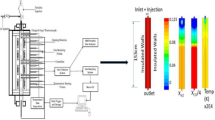Abstract
Spent pot lining (SPL) management represents a major concern for aluminum smelters. There are two key elements for spent pot lining management: recycling and safe storage. Spent pot lining waste can potentially have beneficial uses in co-firing in cement plants. Also, safe storage of SPL is of utmost importance. Gas generation of SPL reaction with water and ignition sensitivity must be studied. However, determining the feasibility of SPL co-firing and developing the required procedures for safe storage rely on determining experimentally all the necessary SPL properties along with the appropriate test methods, recognized by emissions standards and fire safety design codes. The applicable regulations and relevant SPL properties for this purpose are presented along with the corresponding test methods.
Similar content being viewed by others
References
M.I. Hassan, A.T. Brimmo, M.O. Ibrahiem, and Y. Shatilla, Light Metals 2013, ed. B.A. Sadler (Hoboken: Wiley, 2013), pp. 851–855.
P.J. Black and B.J. Cooper, Light Metals 2016, ed. E. Williams (Hoboken: Springer, 2016), pp. 461–466.
Regulation No. 40 C.F.R. § 261.32, U.S Code of Federal Regulations (Washington, DC, 2003).
G. Hansen, Report No. EPA 530-R-12-001, U.S Environmental Protection Agency (Washington, DC, 2015).
R. Jeltsch, Essential Readings in Light Metals: Volume 4 Electrode Technology for Aluminum Production, eds. A. Tomsett and J. Johnson (Hoboken: Springer, 2016), pp. 888–893.
V. Gomes, P.Z. Drumond, J.O.P. Neto, and A.R. Lira, Essential Readings in Light Metals, eds. A. Tomsett, and J. Johnson (Hoboken: Wiley, 2013), pp. 1057–1063.
R.P. Pawlek, Light Metals 2012 (New York: Wiley, 2012), pp. 1312–1317.
ASTM D346/D346 M-11 Standard Practice for Collection and Preparation of Coke Samples for Laboratory Analysis (West Conshohocken: ASTM International, 2011).
Regulation No. 40 C.F.R. § 268.40, U.S Code of Federal Regulations (Washington, 2003).
SW-846 Test Method 9012B, Total and Amenable Cyanide (Automated Colorimetric, With Off-Line Distillation) (Washington: U.S Environmental Protection Agency, 2004).
V.Y. Bazhin and R.K. Patrin, Refract. Ind. Ceram. 52, 63 (2011).
K. Tschöpe, C. Schøning, J. Rutlin, and T. Grande, Metall. Mater. Trans. B 43, 290 (2012).
G. Holywell and R. Breault, JOM 65, 1441 (2013).
M. Reverdy, A. Zarouni, J.-L. Faudou, Q. Galadari, A.A. Zarouni, S. Akhmetov, K.A. Aswad, M. Al-Jallaf, W.A. Sayed, and V. Potocnik, Light Metals 2013, ed. B.A. Sadler (Hoboken: Wiley, 2013), pp. 553–556.
M.L. Free, M. Moats, G. Houlachi, E. Asselin, and J. Yurko, Electrometallurgy 2012 (Somerset: Wiley, 2012).
A. Yurkov, Refractories for Aluminium: Electrolysis and the Cast House, ed. A. Yurkov (New York: Springer, 2015), pp. 65–208.
S. Poncsák, L. Kiss, A. Belley, S. Guérard, and J.-F. Bilodeau, Light Metals 2015, ed. M. Hyland (NewYork: Springer, 2016), pp. 655–659.
S. Akhmetov, D. Whitfield, M.M. Al-Jallaf, A. Al-Zarouni, A. Arkhipov, A. Al-Redhwan, and W.A. Sidou, Light Metals 2013, ed. B.A. Sadler (Hoboken: Wiley, 2013), pp. 561-565.
B. Meirelles and H. Santos, Light Metals 2014, ed. J. Grandfield (New York: Springer, 2016), pp. 565–570.
P.A. Alsop, The Cement Plant Operations Handbook, 5th ed. (Surrey: Tradeship Publications Ltd, 2007), p. 57.
ASTM C92-95(2015) Standard Test Methods for Sieve Analysis and Water Content of Refractory Materials (West Conshohocken: ASTM International, 2015).
ASTM D7348-13 Standard Test Methods for Loss on Ignition (LOI) of Solid Combustion Residues (West Conshohocken: ASTM International, 2013).
ASTM D3176-15 Standard Practice for Ultimate Analysis of Coal and Coke (West Conshohocken: ASTM International, 2015).
D.R. Augood, Light Metals, ed. R.E. Miller (New Orleans: TMS, 1986), pp. 979–992.
ASTM D2650-10(2015) Standard Test Method for Chemical Composition of Gases by Mass Spectrometry (West Conshohocken: ASTM International, 2015).
V. Ebadat, Testing To Assess Explosion Characteristics Of Dust Clouds (NFPA, 2009), http://www.nfpa.org/news-and-research/fire-statistics-and-reports/research-reports/proceedings/2009-proceedings/symposium-on-dust-explosion-hazard-recognition-and-control. Accessed 10 May 2017.
D.W. Green and R.H. Perry, Perry’s Chemical Engineers’ Handbook, 8th ed., chap. 20 (New York: McGraw-Hill Education, 2007), p. 7.
ASTM E1226-12a, Standard Test Method for Explosibility of Dust Clouds (West Conshohocken: ASTM International, 2012).
Author information
Authors and Affiliations
Corresponding author
Rights and permissions
About this article
Cite this article
Ospina, G., Hassan, M.I. Spent Pot Lining Characterization Framework. JOM 69, 1639–1645 (2017). https://doi.org/10.1007/s11837-017-2437-0
Received:
Accepted:
Published:
Issue Date:
DOI: https://doi.org/10.1007/s11837-017-2437-0




